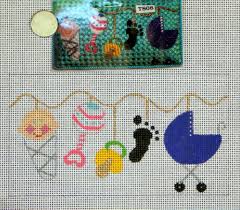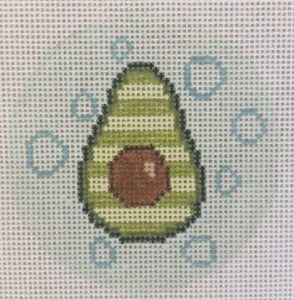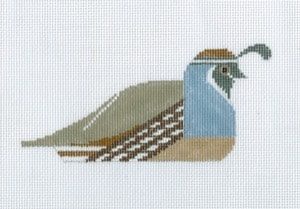
I have taken several classes on painting canvas, so I know how to do it, I’m just not professional quality. Recently I got asked about learning how to do this. Because there isn’t much printed material on this subject, I’ve collected lots of information into this article.
The Process of Painting
The first step in painting your own canvas is to transfer the design onto the canvas. You do this by tracing the design using an extra fine marker made for marking fabrics. The best choices are Pigma Microns from Sakura and SC-UF markers from Pilot. This article from the archives has the steps.
Once your design is transferred, you can start to paint. Use acrylic paints; oil paints take far too long to dry.
Your paint should be thinned with water to about the consistency of cream. To do this, put out some paint on your palette and draw a bit out from the blob. Using your brush and your jar of clean water, add water to the area you have drawn out until it’s the right consistency.
Before you start to paint the canvas, dab the brush several times onto newspaper until the brush is almost dry. You want to use as little paint as possible on the canvas.
Paint the areas, being sure to go over the lines you drew and striving for an even coat. (Evenness in painting is not as important if you are painting just for yourself.)
If you are stitch painting, you paint intersection by intersection, so that each intersection is only a single color. This can make the process very slow.
Paint one color at a time, preferably from light to dark. Clean your brush thoroughly after each color or, better yet, use a new brush for each color.
Once you are finished painting your canvas, let it dry for several hours.
Copyright & Painting

Many things in this world are protected by copyright and that can make it very difficult if you plan to paint canvases and sell your work. Before you start a commercial needlepoint business, familiarize yourself with copyright law. There are many good Internet resources on this for artists and graphic artists.
If you are painting for yourself, there is a wider scope of things you can use. For example if you see an outline or an image that is labelled “for personal use,” you may use it for your own projects, but you must ask permission or get a commercial license for any other use.
Some commercial licenses restrict in other ways. For example Dover’s royalty-free license limits the number of images you can use from a single book. It’s always good to look at the license terms and ask.
If you are creating your own design, remember that you own the copyright to it.
My best advice for negotiating this tricky area is “when in doubt, ask.”
Tips

- You will know if you are using too much water if the canvas buckles as you paint. If you are painting for yourself, this is not a disaster. If you are painting commercially, this is not acceptable. These wavy canvases are very soft; always use stretcher bars when stitching them.
- Painting canvas is very hard on brushes. Use cheap brushes because the canvas will chew up expensive ones just the same. I often use foam brushes for painting backgrounds and large non-detailed areas.
- Any acrylic paints will work, including the bottled craft paints in stores. Artist’s acrylics, such as Liquitex and Golden, differ from these in that they have more pigment in the paint. If you are painting for yourself, the advantage with craft acrylics is that you don’t need to mix colors as much.
- You’ll need a palette for putting out your paints. I like to use small foam plates like you use at picnics. They are big enough for this use, waterproof, cheap, and disposable. I got this tip from a professional canvas painter.
- You will always need to have two jars of water on your work surface. One has clean water & is used only for diluting your paint. The other is used for cleaning brushes.
- It’s important to use clean brushes because leftover paint on the brush can pollute the new color you are painting.
- If holes clog as you paint, you can do something to unclog them. If the paint is still wet you can blow through the hole to clear it. Some folks use blow dryers set on low for this. If the paint is dry, you can open the hole with a large needle.
- If you have started but not finished your painting, you can save your palette. Put plastic wrap over it and store it flat.
- Strive for an even coat. If you are painting for yourself, it does not have to be perfectly even, but there should not be white intersections or patches. You can paint more than one coat
- If you are painting on dark canvas, fill in the entire area to be painted with white paint first and let it dry; this will make the painting on the canvas pop out from the dark background. This makes it easier to stitch as well.
- Mistakes will happen. You can paint them over by letting the mistake dry and then painting over it with paint to match the canvas.
About Janet M Perry
Janet Perry is the Internet's leading authority on needlepoint. She designs, teaches and writes, getting raves from her fans for her innovative techniques, extensive knowledge and generous teaching style. A leading writer of stitch guides, she blogs here and lives on an island in the northeast corner of the SF Bay with her family

Leave a Reply